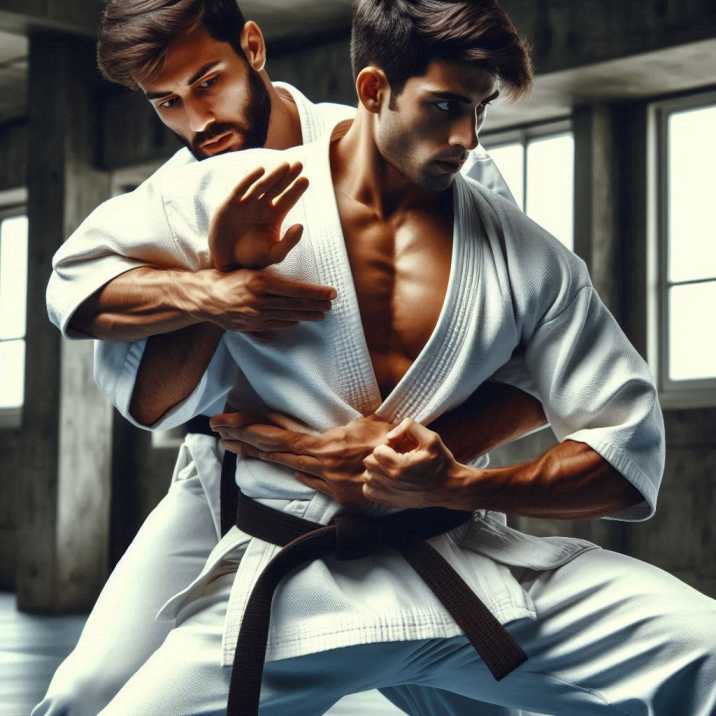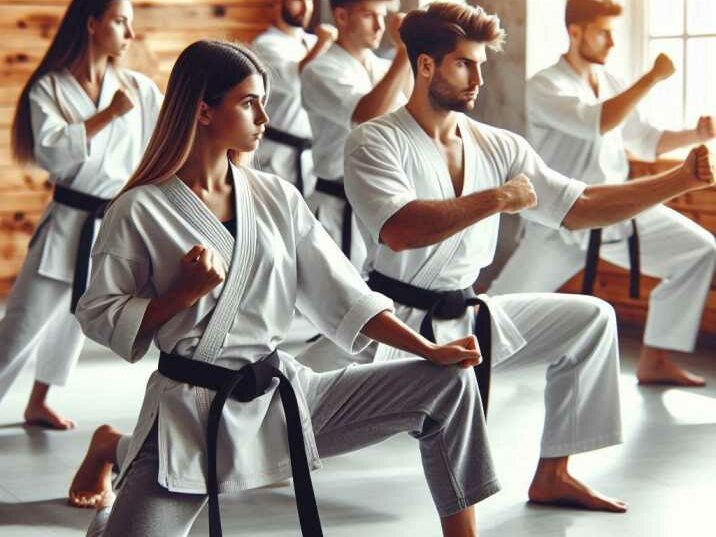Introduction
Table of Contents
In the vast world of martial arts, practitioners and enthusiasts alike often debate the effectiveness of different styles. One such martial art that frequently enters this discussion is Hapkido. Known for its diverse techniques and adaptability, Hapkido is often touted as an effective means of self-defense. But how effective is it really? In this blog post, we’ll delve deep into the art of Hapkido, examining its history, techniques, and real-world applications to understand is Hapkido effective? Whether you’re a martial arts novice or a seasoned practitioner looking to expand your knowledge, this guide will provide a comprehensive look at what makes Hapkido a unique and powerful martial art.

What is Hapkido?
Hapkido is a Korean martial art that focuses on self-defense, incorporating a wide range of techniques including strikes, joint locks, throws, and grappling. The term “Hapkido” translates to “the way of coordinated power,” reflecting its philosophy of using an opponent’s energy against them. This martial art emphasizes fluid movements and circular motions, allowing practitioners to effectively counter and neutralize attacks with minimal effort.
Historical Background
Hapkido’s origins can be traced back to the early 20th century, drawing influences from various martial arts such as Daito-ryu Aiki-jujutsu, Taekkyeon, and traditional Korean fighting methods. The founder of modern Hapkido, Choi Yong-Sool, studied Daito-ryu Aiki-jujutsu in Japan before returning to Korea, where he began teaching and further developing the art. Over time, his students and their successors continued to refine and expand the techniques, leading to the diverse and comprehensive martial art we know today.
Key Techniques of Hapkido
One of the defining features of Hapkido is its wide array of techniques, which makes it a versatile and adaptable martial art. Here are some key techniques that highlight its effectiveness:
1. Joint Locks
Joint locks are a core component of Hapkido, used to control and immobilize opponents. These techniques involve manipulating the joints to cause pain or limit movement, allowing practitioners to subdue attackers with minimal force.
- Elbow Locks: Effective for neutralizing punches and strikes.
- Wrist Locks: Used to control and redirect an opponent’s force.
- Shoulder Locks: Enable control over an opponent’s upper body.
2. Throws and Takedowns
Hapkido employs various throws and takedowns to unbalance opponents and bring them to the ground, where they can be controlled or incapacitated.
- Hip Throws: Utilize leverage to lift and throw opponents.
- Leg Sweeps: Target an opponent’s legs to disrupt their balance.
- Reaps: Use an opponent’s momentum to take them off their feet.
3. Strikes
Strikes in Hapkido are designed to target vulnerable areas, delivering powerful blows that can incapacitate an attacker.
- Punches: Direct and powerful strikes to vital areas.
- Kicks: High-impact techniques that target the legs and torso.
- Knee Strikes: Close-range attacks that exploit openings in an opponent’s defense.
4. Defensive Techniques
Hapkido emphasizes defensive techniques that allow practitioners to avoid or neutralize attacks without directly confronting an opponent’s strength.
- Redirections: Use circular motions to deflect incoming strikes.
- Evasion: Swift movements to dodge attacks and reposition.
- Counterattacks: Exploit openings created by an opponent’s aggression.
The Effectiveness of Hapkido in Real-World Situations
Self-Defense Applications
Hapkido’s comprehensive approach to self-defense makes it particularly effective in real-world scenarios. Its techniques are designed to be practical and adaptable, allowing practitioners to respond effectively to a wide range of threats. By emphasizing joint locks, throws, and redirections, Hapkido enables individuals to neutralize attackers without relying on brute strength, making it accessible to people of all sizes and strengths.
Psychological Aspects
Beyond its physical techniques, Hapkido also incorporates mental training that enhances its effectiveness in self-defense situations. Practitioners are taught to maintain calm and focus under pressure, improving their ability to assess threats and respond appropriately. This mental discipline is crucial in high-stress encounters, where quick thinking and composure can make the difference between safety and harm.
Comparing Hapkido to Other Martial Arts
To truly understand the effectiveness of Hapkido, it’s essential to compare it to other popular martial arts. Here are some comparisons with other well-known styles:
Hapkido vs. Taekwondo
- Focus: While Taekwondo emphasizes striking, particularly with kicks, Hapkido offers a more balanced approach with joint locks, throws, and strikes.
- Versatility: Hapkido’s diverse techniques make it more adaptable to different situations, whereas Taekwondo is primarily focused on offensive strikes.
Hapkido vs. Judo
- Grappling: Judo is renowned for its grappling techniques and throws, which are also a significant aspect of Hapkido.
- Joint Locks: Hapkido incorporates more joint locks and pressure point techniques, providing additional options for controlling opponents.
Hapkido vs. Brazilian Jiu-Jitsu (BJJ)
- Ground Fighting: BJJ specializes in ground fighting and submissions, whereas Hapkido focuses more on standing techniques and transitions to ground control.
- Self-Defense: Hapkido’s emphasis on joint locks and throws offers practical self-defense strategies that can be applied in various scenarios.
Training in Hapkido
Physical Benefits
Training in Hapkido provides numerous physical benefits, including improved strength, flexibility, and cardiovascular fitness. The diverse techniques require practitioners to develop a well-rounded physical condition, enhancing their overall health and well-being.
Mental and Emotional Growth
Hapkido training also fosters mental and emotional growth, teaching practitioners discipline, focus, and perseverance. The mental challenges of mastering complex techniques help build resilience and confidence, qualities that extend beyond the dojo and into everyday life.
Criticisms and Misconceptions
While Hapkido is praised for its effectiveness, it is not without its criticisms and misconceptions. Some argue that its wide range of techniques can be overwhelming for beginners, requiring a longer learning curve compared to more specialized martial arts. Additionally, the effectiveness of Hapkido often depends on the quality of instruction and the practitioner’s commitment to training.
How to Choose a Hapkido School
When considering Hapkido training, selecting the right school is crucial to ensure effective learning and skill development. Here are some tips for choosing a suitable Hapkido school:
- Instructor Credentials: Look for instructors with a proven track record and experience in teaching Hapkido.
- Class Structure: Evaluate the class structure to ensure it includes a balance of technique instruction, practical application, and sparring.
- School Reputation: Research the school’s reputation within the martial arts community to ensure it is respected and recognized.

Table of Information about Is Hapkido Effective?
| Aspect | Details |
|---|---|
| Origin | Korea, early 20th century |
| Founder | Choi Yong-Sool |
| Focus | Self-defense using joint locks, throws, strikes, and grappling |
| Key Techniques | Joint locks, throws, strikes, and defensive redirections |
| Philosophy | Use an opponent’s energy against them with fluid and circular movements |
| Benefits | Physical: Strength and flexibility <br> Mental: Discipline and focus |
| Comparison | More balanced than Taekwondo, incorporates joint locks like Judo, focuses on standing techniques vs. BJJ |
| Self-Defense | Adaptable to various threats, effective for all ages and skill levels |
| Criticisms | Complexity for beginners, relies on quality instruction |
Conclusion
Is Hapkido Effective? Hapkido stands out as a versatile and effective martial art, combining a wide range of techniques with a focus on practical self-defense. Its adaptability and emphasis on using an opponent’s energy against them make it a powerful tool for personal protection. Whether you’re seeking to enhance your self-defense skills, improve your physical fitness, or gain mental discipline, Hapkido offers a comprehensive path to achieving these goals. As with any martial art, the key to unlocking its full potential lies in dedicated practice and a commitment to continuous learning.
FAQs
1. Is Hapkido suitable for all ages?
Yes, Hapkido can be adapted for all ages and fitness levels, making it accessible to children, adults, and seniors.
2. How long does it take to become proficient in Hapkido?
The time to proficiency varies depending on individual commitment and training frequency, but many practitioners see significant progress within a few years.
3. Can Hapkido be used in mixed martial arts (MMA) competitions?
While Hapkido is primarily a self-defense art, some techniques can be adapted for MMA, particularly joint locks and throws.
4. Is Hapkido effective against armed attackers?
Hapkido includes techniques for disarming attackers, but success in such situations depends on the practitioner’s skill level and situational awareness.
5. Do I need prior martial arts experience to learn Hapkido?
No prior experience is necessary; Hapkido is suitable for beginners and experienced martial artists alike.


